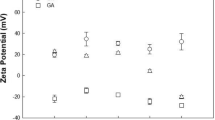Abstract
Styralyl acetate (SA) was encapsulated in gelatin and gum Arabic using complex coacervation. The response surface methodology was carried out to explore effects of wall concentration and the amount of SA on the yield, encapsulation efficiency, and oil loading capacity and to optimize the process conditions. The results of optimization showed that the wall concentration of 1.35 % (w/v) and the SA of 2.23 g were used, the highest yield of 72.8 %, encapsulation efficiency of 80.6 % and oil loading capacity of 66.2 % were obtained. The morphologies were observed by an optical microscope and scanning electron microscopy (SEM), respectively. Microcapsules exhibited excellent thermal stability than SA by thermogravimetric analysis (TGA). Moreover, Fourier transform infrared and X-ray diffraction examined structure changes of wall materials and core oil.






Similar content being viewed by others
References
Siow LF, Ong CS (2013) Effect of pH on garlic oil encapsuleation by complex coacervation. J Food Process Technol 4:199–204
Gouin S (2004) Microencapsulation: industrial appraisal of existing technologies and trends. Trends Food Sci Tech 15:330–347
Han GT, Yang Z, Peng Z, Wang G, Zhou M, Pang YX, Li PW (2013) Preparation and properties analysis of slow-release microcapsules containing patchouli oil. Adv Mater Res 641:935–938
Hong YH, McClements DJ (2007) Formation of hydrogel particles by thermal treatment of β-lactoglobulin-chitosan complexes. J Agric Food Chem 55:5653–5660
Yu YT, Liu LN, Zhu XL, Kong XZ (2012) Microencapsulation of dodecyl acetate by complex coacervation of whey protein with acacia gum and its release behavior. Chin Chem Lett 23:847–850
Oliveira AC, Moretti TS, Boschini C (2007) Stability of microencapsuleated B. lactis (BI 01) and L. acidopilus (LAC 4) by complex coacervation followed by spray drying. J Microencapsul 24:685–693
Jones OG, Lesmes U, Dubin P, McClements DJ (2010) Effect of polysaccharide charge on formation and properties of biopolymer nanoparticles created by heat treatment of β-lactoglobulin–pectin complexes. Food Hydrocoll 24:374–383
Sutaphanit P, Chitprasert P (2014) Optimisation of microencapsulation of holy basil essential oil in gelatin by response surface methodlogy. Food Chem 150:313–320
Zuanon LAC, Malacrida CR, Telis VRN (2013) Production of turmeric oleoresin microcapsules by complex coacervation with gelatin–gum Arabic. J Food Process Eng 36:364–373
Dong ZJ, Xia SQ, Hua S, Hayat K, Zhang XM, Xu SY (2008) Optimization of cross-linking parameters during production of transglutaminase-hardened spherical multinuclear microcapsules by complex coacervation. Colloid Surf B 63:41–47
Zhang K, Zhang HM, Hu XC, Bao SS, Huang H (2012) Synthesis and release studies of microalgal oil-containing microcapsules prepared by complex coacervation. Colloid Surf B 89:61–66
Maji TK, Hussain MR (2009) Microcapsulation of zanthoxylum limonella oil in genipin crosslinked chitosan-gelatin complex for mosquito repellent application. J Appl Polym Sci 111:779–785
Liu S, Low NH, Nickerson MT (2010) Entrapment of flaxseed oil within gelatin-gum Arabic capsules. J Am Oil Chem Soc 87:809–815
Pedroza Ialas R, Vernon Carter EJ, Durán Domínguez C, Trejo-Martínez S (1999) Using biopolymer blends for shrimp feedstuff microencapsulation I. Microcapsule particle size, morphology and microstructure. Food Res Int 32:367–374
Yang Y, Anvari M, Pan CH, Chung DH (2012) Characterisation of interactions between fish gelatin and gum Arabic in aqueous solutions. Food Chem 135:555–561
Turgeon SL, Schmitt C, Sanchez C (2007) Protein-polysaccharide complexes and coacervates. Curr Opin Colloid Interface 12:166–178
Zhang ZQ, Pan CH, Chung DH (2011) Tannic acid cross-linked gelatin-gum Arabic coacervate microspheres for sustained release of allyl isothiocyanate: characterization and in vitro release study. Food Res Int 44:1000–1007
Dong ZJ, Touré A, Jia CS, Zhang XM, Xu SY (2007) Effect of processing parameters on the formation of spherical multinuclear microcapsules encapsulating peppermint oil by coacervation. J Microencapsul 24:634–646
Tatar F, Kahyaoglu T (2014) Microencapsulation of anchovy oil: emulsion characterization and optimization by response surface methodology. J Food Process Preserv 1745:1–10
McNamee BF, O’Riorda ED, O’Sullivan M (1998) Emulsification and microencapsulation properties of gum Arabic. J Agric Food Chem 46:4551–4555
Qv XY, Zeng ZP, Jiang JG (2011) Preparation of lutein microencapsulation by complex coacervation method and its physicochemical properties and stability. Food Hydrocoll 25:1596–1603
Kim SJ, Cho SY, Kim SH, Song OJ, Shin IS, Cha DS, Park HJ (2008) Effect of microencapsulation on viability and other characteristics in Lactobacillus acidophilus ATCC 43121. LWT Food Sci Technol 41:493–500
Xiao ZB, Liu WL, Zhu GY, Zhou RJ, Niu YW (2013) Production and characterization of multinuclear microcapsules encapsulating lavender oil by complex coacervation. Flavour Fragance J 29:166–172
Zhu GY, Xiao ZB, Zhou RJ, Zhu YL (2014) Study of production and pyrolysis characteristics of sweet orange flavor-β-cyclodextrin inclusion complex. Carbohydr Polym 105:75–80
Lv Y, Zhang X, Abbas S, Karangwa E (2012) Simplified optimization for microcapsule preparation by complex coacervation based on the correlation between coacervates and the corresponding microcapsule. J Food Eng 111:225–233
Devi N, Maji TK (2011) Study of complex coacervation of gelatin a with sodium carboxymethyl cellulose: microencapsulation of neem (Azadirachta indica A. Juss.) seed oil (NSO). Int J Polym Mater 60:1091–1105
Ki CS, Baek DH, Gang KD (2005) Characterization of gelatin nanofiber prepared from gelatin-formic acid solution. Polymer 46:5094–5102
Borkovska L, Korsumska N, Stara T (2014) Photoluminescence and structural properties of CdSe quantum dot-gelatin composite films. Physica B 453:86–91
Li C, Zhu WZ, Xue HR (2015) Physical and structural properties of peanut protein isolate-gum Arabic films prepared by various glycation time. Food Hydrocoll 43:322–328
Acknowledgments
This work was financially supported by the National Natural Science Fund of China (21276157,21476140).
Author information
Authors and Affiliations
Corresponding author
Rights and permissions
About this article
Cite this article
Xiao, Z., Li, W. & Zhu, G. Effect of wall materials and core oil on the formation and properties of styralyl acetate microcapsules prepared by complex coacervation. Colloid Polym Sci 293, 1339–1348 (2015). https://doi.org/10.1007/s00396-015-3515-x
Received:
Accepted:
Published:
Issue Date:
DOI: https://doi.org/10.1007/s00396-015-3515-x




